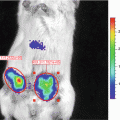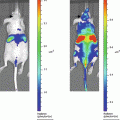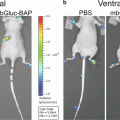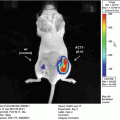(1)
Department of Microbiology and Immunology, Center for Predictive Medicine for Biodefense and Emerging Infectious Diseases, University of Louisville School of Medicine, Louisville, KY, USA
Abstract
Diagnostic imaging is a powerful tool that has recently been applied towards the study of infectious diseases. Optical imaging of bioluminescently labeled bacteria in infected animals allows for real-time analysis of bacterial proliferation and dissemination during infection without sacrificing the animal. Imaging also allows for tracking of disease progression in an individual subject over time, has the potential to reveal previously overlooked sites of infection, and reduces the number of research animals used in pathogenesis studies. Here, we describe the use of a deep-cooled CCD camera imager to record light emitted from bacteria during infection. We also describe the process of correlating bioluminescence to bacterial numbers by ex vivo imaging of necropsied tissues. Together these techniques can be used to estimate bacterial burdens in host tissues both in vivo and ex vivo using bioluminescent imaging.
Key words
Optical diagnostic imagingBioluminescenceSurrogate disease modelIVIS SpectrumAlternative approach1 Introduction
Conventional techniques to study microbial pathogenesis in mammalian models have primarily relied on end point assays (e.g., survival analysis or lethal dose 50 [LD50]) or on sacrificing animals at designated time points to characterize bacterial dissemination to specific tissues. The development of noninvasive approaches to image disease progression, without having to sacrifice the animal, allows for a temporal, real-time analysis of host–pathogen interactions. The use of such noninvasive techniques also facilitates reduction of animal numbers required for these studies—one of the three R’s of good laboratory animal practice [1].
In this chapter, we describe the use of optical diagnostic imaging to characterize bacterial disease progression within a small animal host. For optical imaging, animals are infected with bacteria that emit light or photons. Currently, two light-emitting modalities exist: fluorescent or bioluminescent bioreporters. Bioluminescent bioreporters have been favored because they tend to be more sensitive than equivalent fluorescent bioreporters and demonstrate a dynamic relationship to bacterial viability, which is lacking in fluorescent systems because of the long half-life of fluorescent proteins in inactivated bacteria [2]. Since first described by Contag et al. [3], bioluminescent bioreporters using bacterial luxCDABE luciferase operons have been developed for many different pathogens. A major advantage of the bacterial luciferase systems over eukaryotic luciferase systems is that the bacterial lux operon also synthesizes the substrate for the luciferase enzyme [2]. Therefore, bioreporters using a bacterial system do not require addition of exogenous substrate (usually through injection prior to imaging) to facilitate optical imaging. This also eliminates the potential complication of bioavailability issues with an exogenously added substrate. Furthermore, bacterial and eukaryotic luciferases have different spectral emissions, allowing for the potential to use both in the same system (i.e., monitor bacteria with a bacterial luciferase bioreporter and immune response with a eukaryotic luciferase bioreporter).
Bioluminescent bioreporters for specific pathogens may be available from commercial sources, requests from other laboratories, or designed and engineered in advance in house. Technical details on the development of specific bioreporters will not be discussed here, but several important criteria should be considered when selecting or designing an appropriate system. First, the reporter should be as sensitive as possible without altering the growth of the bacterium. This can be achieved by increasing the copy number of the reporter (i.e., expression from a plasmid vs. chromosome) or by engineering a highly active promoter to drive the expression of the luxCDABE operon. Second, the reporter must be maintained by the bacterium throughout the entire course of the animal infection. Integration of the luxCDABE reporter into the genome or onto a plasmid with a toxin–antitoxin selection system can improve stability of the reporter genes. Finally, the expression of the reporter should be constitutive during infection so that bioluminescence closely correlates with the number of viable bacteria regardless of the time or location being imaged. This can also be controlled through empirical selection of a promoter to control the transcription of the luciferase operon. However, as each new model is being developed, extensive in vivo and ex vivo characterization of the bioreporter in regard to bioluminescence and actual bacterial numbers needs to be determined to establish if bioluminescence directly correlates to bacterial load.
The following technique focuses on using optical imaging and subsequent data analysis to characterize bacterial infection in small animal models using intranasal instillation of Yersinia pestis as an example. However, similar approaches can be applied to a variety of bacterial pathogens and routes of inoculation.
2 Materials
2.1 Bacterial Infection
2.
Spectrophotometer.
3.
P20 pipettor.
2.2 Whole Animal Live Imaging
1.
Appropriate mouse strain (see Note 1).
2.
IVIS Spectrum (Perkin Elmer).
3.
Living Image 3.0 Software (Perkin Elmer) for image collection from the IVIS Spectrum and performing post-capture data analysis.
4.
XGI-8 anesthesia system and isoflurane/oxygen inhalation anesthetic to maintain sedation during image capture.
5.
f/AIR isoflurane scavenging charcoal filters: filters should be weighed routinely, and retired when they have absorbed 50 g of additional weight.
6.
Anesthesia manifold with nose cones and dividers, transparency, and black construction paper (see Note 2).
7.
Forceps.
2.3 Ex Vivo Tissue Imaging
1.
Sterile black 24-well plates (see Note 3).
2.
Sterile surgical instruments.
3.
Sterile Whirl-Pak 1 oz bags (Nasco): the sealing strip removed and the dry weight of the bag recorded in advance.
4.
Sterile 1× phosphate buffered saline (PBS).
5.
Pathogen-specific nutrient agar plates.
3 Methods
3.1 Animal Husbandry and Preparing the IVIS Spectrum
1.
One week prior to infection studies, mice are transitioned onto an alfalfa-free rodent chow to reduce the alfalfa-related luminescent background in the gut.
2.
Three to four days prior to infection studies, mice are shaved using a veterinary clipper with a size 30–40 blade. Removal of fur increases the sensitivity of detection of bioluminescent bacteria (see Note 1).
3.
Individual mice within a group are identified using black Sharpie tail banding, toe tattooing, or ear tags (see Note 4).
4.
The day before imaging begins, launch the Living Image software and initialize the IVIS Spectrum. Ensure that the Auto Background Settings/Dark Charge measurements are current by manually acquiring the Background (under the Acquisition tab) (see Note 5).
5.
Prepare the sample stage within the IVIS Spectrum. Place a transparency on the sample stage and then one sheet of black construction paper on top of the transparency. Insert the nose cones and dividers into the anesthesia manifold on the imaging stage (see Note 2).
3.2 Preparation of Y. Pestis Inoculum and Animal Inoculation
1.
Three days before mouse inoculation, inoculate a BHI agar plate with a scraping from −80 °C glycerol stock of frozen culture of Y. pestis LuxP tolC . Grow for 2 days at 26 °C.
2.
The day before mouse inoculation, inoculate a 5 ml BHI broth culture with a 1 in. streak of multiple colonies from the BHI plate. Grow for 6–8 h on a roller drum at 26 °C.
3.
Determine the OD600 of the 26 °C culture using the spectrophotometer and dilute bacteria to an OD600 of 0.05 in 10 ml of prewarmed BHI + 2.5 mM CaCl2 (in a 125 ml flask).
4.
Grow for 16–18 h at 37 °C shaking at 250 RPM.
5.
Determine the OD600 of the 37 °C culture using the spectrophotometer and perform serial dilutions as shown in Table 1 in 1 ml of sterile 1× PBS. Spot plate 20 μl from dilution tubes 5, 6, and 7 on BHI agar and grow for 2 days at 26 °C to determine the inoculum concentration (see Note 6).
Table 1
Dilution schedule for Y. pestis inoculums
Tube | 1 | 2 | 3 | 4 | 5 | 6 | 7 |
|---|---|---|---|---|---|---|---|
Dilution (in 1 ml PBS) | 1 OD600 | 1:3 | 1:10 | 1:10 inoculum | 1:10 plate for CFU |









